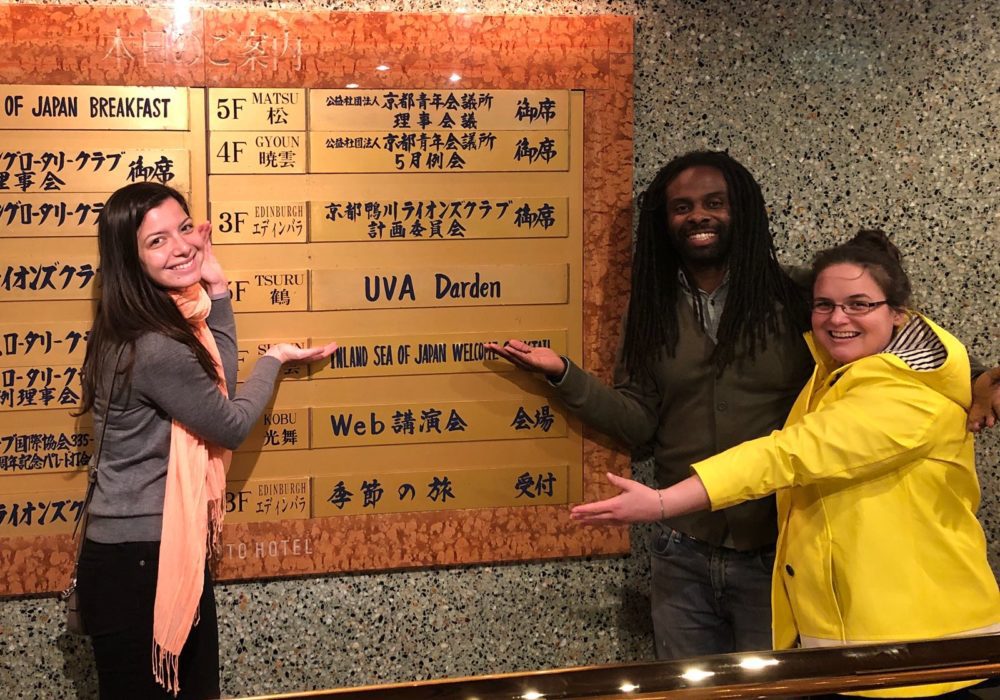King Adjei-Frimpong is a rising second-year student at Darden. Following graduation from UCLA, King worked for years in Northeastern Pennsylvania for the Commission on Economic Opportunity, a nonprofit organization that promotes self-sufficiency among low-income and vulnerable populations by confronting the causes of poverty. This past spring, he took the opportunity to participate in the Darden Worldwide Course to Japan on Innovation and Tradition. King had the following to share about his experience in Japan with the Darden Worldwide Course:
What attracted you to the Darden Worldwide Courses and to the course in Japan more specifically?
I was aware of the Darden Worldwide Courses before I ever stepped foot on the Darden grounds. I knew that it was an invaluable opportunity I wanted to take advantage of during my time at Darden. I pursued the international opportunities at Darden for quite some time and was intrigued by the Darden Worldwide Courses that had gone to Cuba and Sweden. When it came time to pick which DWC would be the best fit for myself, I weighed the options and ultimately decided to participate in the Japan DWC. I was particularly interested in the Japan DWC because it was led by faculty member Yael Grushka-Cockayne. I first met Professor Grushka-Cockayne during a welcome event at Darden for new MBA students and she was unfailingly kind and welcoming. She is a highly respected professor and I jumped at the opportunity to participate in a course that she was leading.
What company/organization visit during the Japan DWC was especially insightful or enlightening?
Perhaps the most intriguing visit was to Kyocera, the Japanese electronics company. Our group learned a great deal about the history of Kyocera and how respected it is as a business in Japan and around the world. The management structure of Kyocera is a rather fascinating business philosophy. Kyocera champions an organizational structure called Amoeba Management. Amoeba Management divides an organization/company into small units, called “amoebas”. While the units are distinct, collaboration is an essential aspect of Amoeba Management and each team member in the unit is tasked with managing the team, achieving a “management by all” approach.
In contrast to a large, multinational company like Kyocera, we also visited a traditional Japanese tea house. This particular tea house was going to close but an individual purchased it in order to uphold this cornerstone of Japanese culture and tradition. The visit perfectly illustrated the theme of tradition and innovation in Japan. Under new ownership, the tea ceremonies were recorded, and videos produced on how to make the perfect cup of tea. This innovative approach upholds tradition while making it more relevant and accessible to a modern society.
Were there any other innovative companies that stood out?
Our group met a gentleman from the U.S. whose wife is Japanese and they started a company that translates movies and video games from Japanese to English and vice-versa. They themselves don’t create the content but rather serve as a bridge between the different cultures and languages. The company, AltJapan, is influencing cultural exchange, by translating the spirit and meaning of content, not just words.
Beyond the company visits, what was a memorable moment from your time in Japan?
My trip to Hiroshima and the memorial ended up being one of the most powerful moments for me. Today, the city brims with modern business skyscrapers and traditional Japanese architecture. The memorial showcases the remnants of the Hiroshima Prefectural Industrial Promotion Hall. The memorial, and the few other buildings that have remained untouched since 1945, raise difficult questions about how to best remember history.
There were groups of all nationalities and ages visiting the memorial. A group of Japanese students at the memorial recognized a moment of silence and internalized the experience. The students paid homage to Sadako Sasaki, a Japanese girl who was two years old when the atomic bomb was dropped on Hiroshima. Sadako became a well-known hibakusha – a Japanese term meaning “a person affected by the bomb.” She is remembered through the story in which she made one thousand origami cranes before dying from the effects of the bomb. There is a memorial to Sadako at the Hiroshima Peace Memorial Park.
What has been a lasting impact of the DWC?
The Darden Worldwide Course affirmed my interest in being more involved in the global aspects of business. The experience has stoked my interest in potentially working abroad, but regardless of where I end up, I am excited about exploring and learning about different regions and cultures. In fact, in the fall semester I am going on exchange to Argentina. The DWC in Japan was a strong impetus to continue with global experiences.





